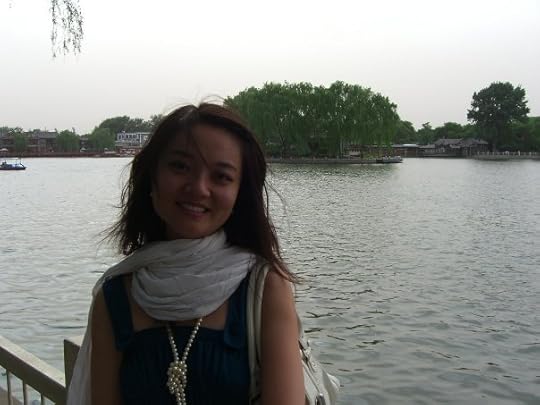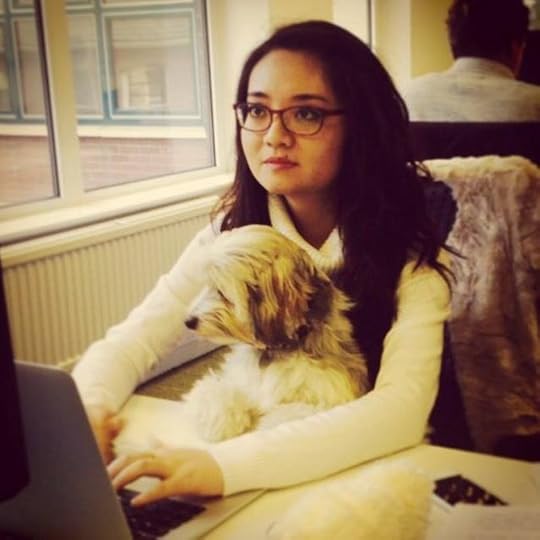Jessica Pan's Blog: Graduates in Wonderland, page 9
February 20, 2014
What Is a Bobo?
We have to admit: we stared at this postcard for a long time trying to figure out what the difference between a Bobo and a Hipster is. The only thing it made us do is laugh at the word “bobo.”
But, a little digging into the words themselves made things clearer. Bobo actually started out as what we would call hipsters before we, uh, knew to call them hipsters? Back in the late 1990s and early 2000s, these were the post-yuppies, the “Bourgeois Bohemians.” The French adopted the same word, probab...
February 19, 2014
Finding A Creative Job After Corporate Life
This is the fourth in an ongoing series in which we interview people who have interesting jobs and get them to tell us how they landed them. They will also reveal how they handled the transition to the real world after graduation —

Kim Mickenberg with her husband, Tobin Marcus
I’ve never met a person like Kim Mickenberg, and I knew this from the moment she moved in across the hall from me during our freshman year at Brown University. She drank copious amounts of coffee (always black), wrote poe...
February 18, 2014
Why Is Grandma’s Hair So Weird?
 Most of us walk around with the belief that everybody wants to look good — or, at least, that nobody actively wants to look bad (unless you are Charlize Theron inMonster).
Most of us walk around with the belief that everybody wants to look good — or, at least, that nobody actively wants to look bad (unless you are Charlize Theron inMonster).
However, if you’re thinking this when you come across an elderly lady, you may take a peek at her poodle-like helmet of hair and conclude that she’s just given up, and that your entire world view is distorted.
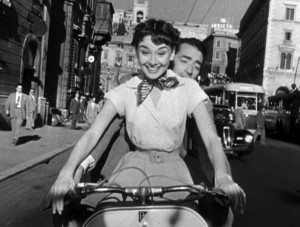
Not so! In fact, that woman has simply reverted to what she thinks of as a “classic” hairstyle, one that Hollywood in...
February 17, 2014
Austenland Reviewed
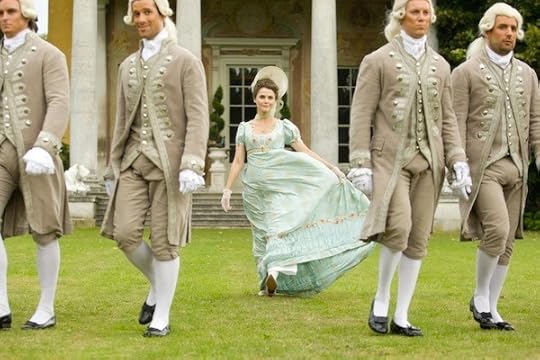 Felicity was one of our favorite shows when we were in middle school (whoa 1998!). Like the beginning of our book, the show begins at a graduation: Felicity chases down her crush, Ben, and then throws away her plans to go to Stanford so she can follow him to NYU. That show was nearly perfect, except for “best friend” Julie, who was not to be trusted. Seriously – when she slept with Ben, she was dead to us. Forever.
Felicity was one of our favorite shows when we were in middle school (whoa 1998!). Like the beginning of our book, the show begins at a graduation: Felicity chases down her crush, Ben, and then throws away her plans to go to Stanford so she can follow him to NYU. That show was nearly perfect, except for “best friend” Julie, who was not to be trusted. Seriously – when she slept with Ben, she was dead to us. Forever.
Anyway, we’ve missed Keri Russell (and we don’t care what length her hair is), but she finally returned to playing a lovable, dreamy character torn between two men – but this time, it’s in England, there are costumes and the men have accents — all in a movie called Austenland.
The premise seems promising: Jane (of course her name is Jane), a woman unlucky in love and obsessed with Jane Austen’s books, spends her life savings on a holiday to an English estate where everything is from the Regency Era: the clothes, the food, the customs, and the men.
We saved the viewing experience for the DVD (which came out last week) because we were turned off by the bad reviews. Terrible reviews.
But guess what?
We both liked it. We embraced its terribleness. Was there too much farce and bravado and little to no backstory for protagonist Jane? Yes. Were there terrible English accents put on by Americans? Yes.
But was there real flirtation and hints at love? Genuine suspense at who Jane would end up with? Did it entertain us? Yes. Yes. Yes!
Jennifer Coolidge’s character (a fellow Austenland visitor) is ridiculous beyond belief (sometimes in a cringe-worthy, how-did-anybody-find-that-funny kind of way) and her impersonation of a British accent which quickly turns into unintentional baby talk is grating and…yet by the end of the movie, it was downright amusing.
There are also a million little jokes that just happen without being dwelled upon or even highlighted. In that way, it has subtlety that every Jennifer Aniston movie lacks. And these guys have charisma.
We felt like we had to write about this movie because it deserved better than those scathing reviews. There were some really good kissing scenes on boats, next to lakes and inside ballrooms. The makeover sequence was hilarious. It is equal to Bridget Jones 2, which means, not as good as the original but definitely worth watching. And Austenland is just as good (actually, better) than the Legally Blonde movies.
Most of all, it fulfilled the deep void we’ve had in our lives ever since Felicity went off air. And there are two distinct horse scenes: one with the stable boy and one with the snobby Englishman, and both are unexpected, strange and amusing.
If you’re into period dramas, farce and love triangles on an English estate, we highly recommend Austenland. It came out on DVD last week – so go watch it and then tell us what you think.
FYI: Jess is in love with Stable Boy Martin and Rachel is love with the Cold English Gentleman Mr. Nobly. This surprises no one.
February 14, 2014
Valentine’s Day Haikus
Follow my blog with Bloglovin
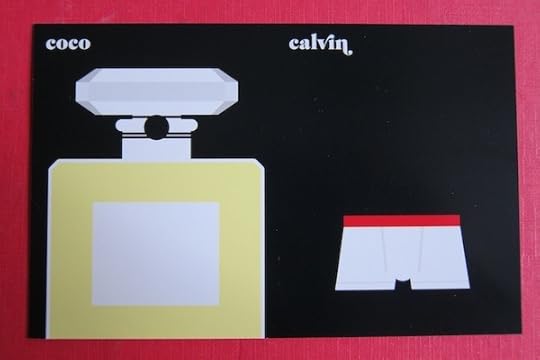 17 syllables to express our feelings on Valentine’s Day
17 syllables to express our feelings on Valentine’s Day
(If you need some Valentine’s Day tips: flowers or chocolate. Tips over). Now onto the haikus.
February 14th:
Snow, sleet, cold, and dark
Mean pants and tights. ‘Til mid-month:
A reason to shave. – KM
Valentine’s Day:
House of Cards is back
V-day. No one is as good
In bed as Netflix. – KM
London Valentine’s Day:
Rain drizzle and rain.
More rain. What a cruel wet world
Skip V-day. Stay in.
And lastly, the famous haiku with an unknown author:
Haikus are easy
but sometimes they don’t make sense
refrigerator
Special thanks to Kim Mickenberg,a high-flying creative from NYC and haiku-writer extraordinaire, who also makes excellent chocolate banana bread (among other things).
Let’s go eat chocolate now.
February 13, 2014
Pioneer Apple Pie
We baked an apple pie for Almanzo Wilder’s birthday over at The Hairpin. We hope you like it, but be warned: the pie crust contains lard.
February 12, 2014
The Story of an International Entrepreneur
This is the part of our ongoing series in which we interview people who have interesting jobs and and get them to tell us how they landed them. They will also reveal how they handled the transition to the real world after graduation —
Siqing (rhymes with cha-ching!) is fluent in English, French and Mandarin, runs her own jewelry business and works full-time on the digital side of a travel company in London.
From age 11, she decided she would not lead an ordinary life. Her post-grad tale is one of hard work, ingenuity (she created her own study abroad exchange program) and relentless drive. Her path takes her from Southern China to France and eventually to London, where she currently lives and works. (We first met at a Chinese supper club in London run by a mutual friend we both met in Beijing.)
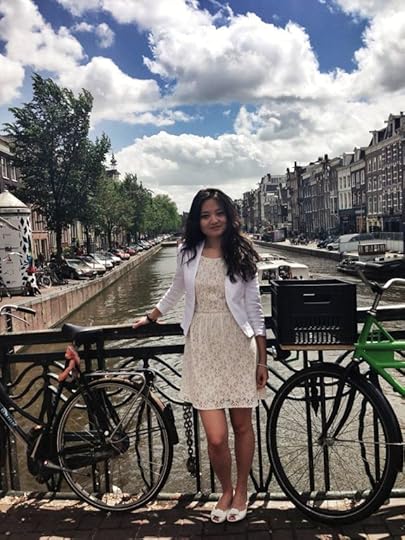
Siqing, in Amsterdam, on a rare day of relaxation
If you’re feeling lazy or need motivation or have ambition to start your own business, read this.
You haven’t led the typical life of a Chinese girl. What was your childhood in Chengdu like?
Most of the time in China, it’s the parents who pressure the kids to study and work hard, but in my case, I’m the one who wanted to do it. There was one really good school in Chengdu, the Chengdu Foreign Languages School. They accept 200 kids out of 20,000. I took evening and weekend courses for an entire year to prepare and when I was 11, I took the entrance exams and was accepted. But my parents never pressured me to do it — I wanted to prove it to myself.
It was a boarding school and we had class from Monday- Saturday. Every day, we had to wake up at 6.40am and go to bed at 10.30pm. Even after dinner, you study. We had to cut our hair short and keep it short for the entire time. The school was almost run like the military.
It was so competitive: the school also “eliminates” kids every year — in my final year (the 6th year), there were only 84 students left out of 200. It was brutal. The kids that get kicked out had to go to ‘normal’ schools. I survived by the skin of my teeth.
If I were in a normal school, maybe I would have been outstanding, but that school was full of geniuses, so I felt mediocre most of the time. I focused on learning English well because that was my best subject.
How did you end up traveling abroad for the first time?
I was the best English student in my class and was part of an exchange program with the States, so when I was 16, I spent a month in Washington, DC.
When I first arrived in America, it was mind-blowing. I felt like I’d landed on a different planet. Things in China were really backwards back then, but I didn’t want to let on.
My American host family had nine bathrooms! I counted so that I could go back to China and tell my friends. Their house was like a palace – I’d get so lost that I couldn’t even find my room sometimes. But the schoolwork at the American high school – it was so easy compared to what we studied! They were a few years behind us in the curriculum and the hours were so short compared to my school in Chengdu.
Back in the school in China, I was considered so weird. I questioned Communism and the idea of mindlessly obeying authority. I was just different from the other kids. There was actually a club of kids devoted to hating me. I don’t know why at all – it was run by some guy I’d barely even spoken to. But in America, I was popular. I even had a really sweet, shy American boyfriend for the month I studied in the States.
What happened after you graduated from high school in China?
I got a double degree from Sichuan University, which is a pretty good university in China. I studied French and business. I spent my first three years there and spent one year studying in France.
Actually, I created the exchange program between the two universities. I met a guy who went to the French school in Chengdu and I decided that I want to make an exchange program between my Chinese university and a university in France.
You created the exchange program?
Yeah – I went to Sichuan University and told them my idea. I lobbied for the two schools to meet – people came over from France and I showed them around and translated at the meetings. I converted the curriculum and scores and negotiated the contracts. It worked out that it wouldn’t be as expensive as studying a year in France outright, since the French students also came to Chengdu. It was the first exchange program for students at Sichuan University.
I started the program when I was a sophomore at college, and then spent my senior year in Dijon, France studying International Trading Commerce at Ecole Supérieure de Commerce de Dijon for the Erasmus.
Why did you study French? Why study in France?
I couldn’t make up my mind about what I wanted to do, but if there’s one thing that will always be useful, it’s a language and I knew I was good at languages. I was buying myself some time. I realize I wanted to go into business because during university, I started working as an interpreter for international conferences where investors come to China to talk to local businesses and look for potential suppliers and investments.
During this time, I learned business phrases and I began to figure out what they were talking about, so I decided to study business and French. Also, I was friends with French expats in Chengdu and I really liked them. It gave me the idea to go there.
What were your first impressions of France?
I loved it. I felt like I’d come home. It was such a strong feeling. I think I was born in the wrong country. Europe is my home. Even before I came here, I knew.
I never missed China, not for a day. Never. I made so many friends in France. And I loved it. My best friends are still from that year.
What did your parents think of your moving to France?
My mom didn’t support the idea. Even though the tuition was low, they still had to pay for my living expenses. She did ask, “Why don’t you just find a job or something?” But my dad encouraged me.
What did you do after you finished your degree in Dijon?
I did my masters degree in international trading at Ecole de Management in a different town in France – Strasbourg. It’s a French Alsatian city with heavy German history, and belonged to Germany many times in the past. I picked up some German when I was there, too.
How did people treat you in France? Was it hard coming from China?
Everyone was really nice to me. I think the French are racist against people who don’t speak French, but my French was already good when I arrived. I remember sitting with a bunch of French students and they were complaining about the other Europeans in their country who don’t speak French. They started complaining about foreigners. I said, “But I’m a foreigner!” And they said, “But you speak French so well! You’re one of us.” I think it’s mostly about the language for them.
What happened after you finished your degree?
After I graduated, I started sending my CV to companies in Europe. I posted it on the professional German website, Viadeo, and someone contacted me about a graduate recruitment program at a gaming company in London.
I was like, “What? London?” That had not crossed my mind at all. I always thought I would stay in Europe – I’d had two interviews for jobs in Switzerland. But I came to London and had to interview for two days at an assessment center and I got the job.
What did you think of London?
London was pretty much like a wonderland to me! That’s actually a very good word. I could understand the language but that was it. The black cabs, the food, everything was very exotic to me. I remember at the hotel I was staying at, there was a breakfast buffet and I asked if they had any croissants because I was used to eating that in France. They just looked at me like, “What?”
And I called everyone ma’am or sir, because in French that’s what you do: madame this, monsieur that. They thought I was so weird, but I got the job.
Tell me about your first job in London.
It was a graduate recruitment program for a gaming company – so I spent months in the marketing and publicity departments but I also had to actually manage a gambling retail shop for six months as part of the program! They were like “You’re Chinese! Manage the shop in Chinatown!” Now that’s racist!
It was one of the hardest jobs I’ve ever done. And everyone spoke Cantonese instead of Mandarin! To be a shop manager you have to do ten things simultaneously. It was a super-overwhelming, crazy job especially when there were angry customers who had just lost money. After those six months, I was trained in the marketing and publicity departments.
How did you feel about working in the gaming industry?
I had some ethical doubts about it, but not serious enough for me to turn down the job. Gambling is a highly regulated industry in the UK and the company actively engaged in programs to make sure customers don’t get addicted, so in a way they were helping a lot more than illegal bookies in countries where gambling was illegal. That being said, I never thought gambling was in any way glamorous and I did try and get out as soon as I could. I don’t think it contributes much value to the society and also, I personally had no interest in sports betting and gaming.
What happened after your first year on the job?
After a year, I found out they’d applied for the wrong visa for me. It meant that when it expired, I had to leave the UK and couldn’t come back for 12 months. They decided to send me to Beijing so that I could meet with Chinese government officials to try to legalize gambling in China. It was PR work and it meant dealing with Chinese officials who assumed I would help them instead of help my company. I hated that job. I saw corruption firsthand and it was not pleasant at all.
One time, one of the officials definitely tried to marry me off to someone’s son! She kept asking me to teach English to a government official’s son and I kept saying no. Finally, I agreed to show up and talk to him about learning English. Then, when I arrived, I realized we were having dinner at a huge table with his entire family: aunts, uncles, grandparents, everyone. They started asking me, “How tall are you” and “Are you healthy?” and “How much money do you make?” I was pretty naïve back then and just kept eating and answering their questions. Only afterwards did I realize, “Wait a minute – I think they were trying to marry me off to that guy!” And he was one of those typical Chinese princelings: chubby and covered in pimples. But I don’t think he liked me, either.
What was it like moving back to China after you’d been living in London and France?
I wanted to go back to London as soon as possible because I loved it so much. It was an amazing adventure: the theatres, the food, the high streets, the immense diversity in culture, the people, my friends. It was so exciting.
The moment I landed in Beijing, I had a plan: I’d apply for a different UK worker’s visa in one year and move back to London.
The best thing I liked about Beijing was it was so easy to make friends and I had a great social life and loved the diversity of people there. But I hated my job. I was really depressed.
I decided that I was going to start my own business. While I was working for the gaming company, I was saving all of my money and managed to save 10,000 pounds (16,410 USD).
I wanted to start a pearl jewelry business. I found pearl suppliers in China and decided that I would sell them in Europe. I launched right into it: I hired a website designer and programmer.
It was a really stressful time. I was living off of my savings and I invested a lot of money into my jewelry company. Buying pearls is actually really expensive and I knew nothing about e-commerce at the time. I was punching in the dark.
Then, I moved back to London and the gaming company contacted me again. They were like “Well, we spent all the time and money training you.” I wanted to learn more about the digital side of things so I met with a guy in the IT department and told him I wanted to learn about websites. He hired me to help manage their internal communications. It was basically an entry-level job but it was web-related, which is what I wanted. It was also less risky for the company to have me working on the internal digital side of things.
I got a lot of on the job training. I asked everyone to tell me what books to read. I found some amazing mentors.
One of my mentors was going on maternity leave and she said, “I’ll train you so you can replace me.” That’s when I moved into the gaming website team, where I worked for two years. I read books on the field all the time. I also read books on cognitive psychology and industrial design, because I knew that when I went looking for another job, I needed my CV to stand out. I needed to prove that even though I didn’t have a degree in website design, I had a breadth of knowledge that other people didn’t have. It helped me a lot in interviews.
I eventually quit the gaming company and started working at agencies as a user experience architect for websites (a UX architect). Everyone in the digital business can improve their CVs and portfolios by working for both agencies and clients.
What is your job in layman’s terms?
I design the blueprint for a website or a mobile app. I choose how to present the information and decide what features a website should have. I create something called a wireframe (or an interactive prototype) which a designer takes and then applies a graphic layer to it. Then a programmer develops it.
My job is to make sure the website or app’s features are intuitive and engaging for the user, while also making sure they are feasible from a technical perspective.
The agencies I worked for had really big brand clients but they’re like sweatshops. I worked for them because I knew I needed to get those big brand names on my CV.
How were you balancing this work with your own company?
When I first moved back to London, I woke up every day at 5am and worked on my jewelry company from 5-8am. Then I’d get ready for work. Every night, I was asleep by 9pm. I had no friends at all. I was poor. I had nothing. I knew I had to get my shit together and work really really hard.
Sometimes when my alarm would go off at 5am, I wouldn’t feel very awake so I’d make myself go for a run along the river and even the swans were still asleep in the water. I was up before even the swans! That’s how early it was.
I couldn’t do that now. I’m too old now! But it was worth it then. And I made back the money I invested within two years.
What is your current job?
I’m technically still a freelancer, but I’ve been working for the same travel company for 18 months now. They are in the process of transforming their business into a digital-led organization. Like previous digital jobs, I was hired as an user experience architect: I helped them figure out their customer experience strategy and build a portfolio of travel apps for phones.
Then I got promoted to the title of Product Owner of a portfolio of these mobile apps. My new role is to define what features the team builds for these apps by working with different country divisions and understanding our customers.
This job is actually very similar to running my own business – I need to think about technical architecture, budget and the team capacity, as well as make sure that the app features bring both customer and business value.
How do you still have time for your jewelry business?
I make sure I block out 4-5 hours to work on my pearl business every Saturday. I’ve just re-launched my jewelry website – it’s called Jacqueline Shaw. I’m really proud of the designs – they’re elegant but great value. I name the designs after actresses that I think represent the beauty and style of the pieces.
What was the turning point in your career?
When the gaming company screwed up my visa and I had to go back to China, I was at a low point. I was heartbroken. I wanted to be an entrepreneur and I was super-driven, but to be honest, my jewelry company didn’t take off as well as I thought it would, at least not as fast as I thought it would. It was not as easy I had thought it would be.
But after working on it so hard and learning about websites – that’s the only way I was qualified to get hired on the intranet side of the gaming company back in London, which lead to everything else. And even when I was working full-time, I took photography courses and accounting courses at night so that I could improve my jewelry business.
Your mom was just visiting you in London for the first time. What does she think about you living here?
Until my mom visited me, she didn’t understand why I was here or that I’m a lot happier here. For a long time she didn’t understand why I would want to leave China. She’d say, “I can’t believe I have a daughter and she doesn’t want to live in China.”
But when she visited, she liked it here. She thought everything was very clean and charming. My career is healthy. She gets it now.
Are you happy with where your career ended up?
I’m really happy I ended up working in the digital industry, even though my studies were unrelated. It’s fun to build digital experiences that people enjoy and the types of people who tend to work in digital are generally cool, creative and unpretentious.
I first began on the architecture and design part of websites but now that I’m a “product owner”, I have an influence on what gets built — it’s a challenging and complex job, and I love challenges.
What’s your advice to recent graduates or anyone who’s struggling with what to do with their life?
This takes me right back to where I was in 2008, working for the gaming company in China. Not only did I hate my job, I hated my life! For someone who feels like this, I would say, never accept this as your reality! Figure out what you’d like to do and then make a plan, then take each and every step to lead you there, no matter how hard or how far it seems.
I mean, literally write down what you would like to achieve on a piece of paper and worship that paper. You might get there way faster than you expect! I think the most important thing, really, is to believe in yourself. It sounds cheesy, but it’s true.
The “Post Grad Dispatches” feature comes out every Wednesday. Stay posted.
February 11, 2014
Pucker Up: Red Lips

Photo from Wikimedia Commons
Here’s a fact that’ll make you feel like a slob: in the 1950s, 98% of American women wore lipstick. But don’t worry too much — for centuries before that, lipstick and rouge were considered the exclusive domain of stage actresses and prostitutes (the two were often not far apart, morally, in the eyes of the public). Classy women didn’t “paint” themselves. They’d tighten their waists to within an inch of their lives in corsets, but God forbid they use some blush! And then Hollywood stepped in.
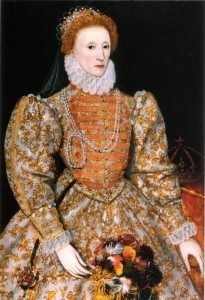
Photo from Wikimedia Commons
Okay, a lot of other things happened first. The origins of lipstick are lost in the annals of time (fancy library talk), but its recorded use goes back to 3,000 B.C. Queen Elizabeth I made red lipstick classy; but her influence didn’t extend to the 1770s, when British Parliament passed a law that stated any woman wearing lipstick could be tried as a witch. However, 300 years after Queen Elizabeth, Queen Victoria declared that any makeup at all was “impolite.” This was way harsher than it sounds, back in the day. It was basically calling make-up wearers whores.
Luckily, this didn’t last long. In the late 18th century, esteemed stage actress Sarah Bernhardt loved her lipstick and took it everywhere with her, even (gasp!) putting it on in public. But it wasn’t until the 1920s invention of the twist-tube that we know today that women could start carrying it around in their pockets.
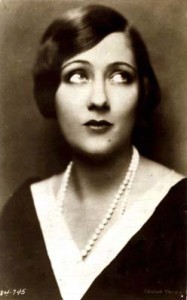
Photo from NNDB
And that was great, because Hollywood was already pushing us to wear more lipstick. Black and white films needed their actresses (and their actors) heavily made-up to show their expressions, near and far. Had films been in full color then, pinks and nudes might have worked just fine: but in the early days of the flickers, they wanted to make the mouth stand out, not blend in. And so the deepest reds were used to highlight the silent mouths. With the popularity of flappers, more and more women began to wear lipstick, and the sight of a dark mouth on-screen was no longer as provocative as it once was.
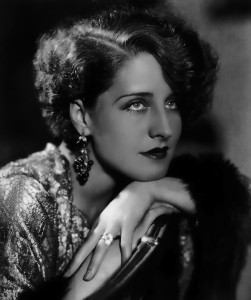
Photo from Doctor Macro
The movies were still filmed in black and white, though, and throughout the 1930s, red (or its grey approximation) remained a popular choice for Hollywood makeup artists. During the Depression and the first world war, lipstick was a luxury; but the women on-screen always had those glossy red lips, that sign of glamour. Soon, with more and more films being made in Technicolor in the 1940s and 1950s, the popularity of the color exploded. It was an instant marker of beauty, glamour, everything that made them different from the average woman (though by this time, of course, the average woman was also wearing red lipstick).
For actresses with cool exteriors, like Hitchcock blonde Grace Kelly, the red lip hinted at something sexier and hotter beneath the surface (Kelly stopped wearing red lipstick almost altogether after leaving Hollywood).
And it didn’t cost a fortune to look like Grace Kelly, either. In fact, studies exist that show when the economy takes a turn for the worse, lipstick sales go up because it’s an inexpensive pick-me-up. The scientific term for this? The Lipstick Effect. Today, hardly a season goes by without magazines proclaiming a resurgence of the red lip (although it never went away).
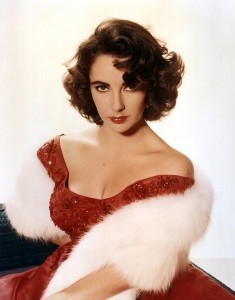
Photo from Wikimedia Commons
Scarlett Johanssen, Taylor Swift, Alexa Chung, and Emma Stone have all, at one point or another, worn lipstick that could be classified as red. But the truth is, despite its high-maintenance look (try keeping your lips that color for more than half a martini), the red lip will never truly go out of style. Red lips are an inexpensive and easy way to say: Yes! I am glamorous, whether I’m wearing ripped jeans or a ballroom gown, whether my hair is messy or pulled back in a French twist.
Our advice? Always check to make sure your teeth are lip stain-free and you’re good to go.
This is part of the weekly series of Rachel’s Old Hollywood Beauty Tips, peripherally based on her UK thesis work so she can justify writing them during the day. You can find out about eyebrows, eyelashes, photo re-touchings and more.
February 10, 2014
Wildlife in London
Spotted this guy eating a nut, but my presence frazzled him, so he dropped it. This is also the same squirrel that likes to scare the living daylights out of me when I’m running, so I consider this revenge.*
And later that day, RIGHT next to SHERLOCK HOLMES’ APARTMENT on Baker Street, I spotted this lovely pair of paramours, just trying to enjoy a stroll in Regents Park and live their lives freely – unfortunately, the chains of humanity had other plans. Still, I managed to catch a happy moment.
(That big dog looks so soft.)
This is the third installment of our series of wildlife found in London.
* I have no proof this is the same squirrel but I’m willing to bet it is.
February 7, 2014
Happy birthday, Laura Ingalls Wilder! We made you lard cakes!
The cakes were too pretty to eat. Mary and Laura just looked at them. But at last Laura turned hers over, and she nibbled a tiny nibble from underneath, where it wouldn’t show. And the inside of that little cake was white!
It had been made of pure white flour, and sweetened with white sugar. – Little House on the Prairie, 1935
The cakes were wonky and lopsided, but still very charming. Jess and Rachel urged their British friend to eat one.
“Go on. Try them. We don’t do this for just anybody.”
Poppy nibbled a tiny nibble from underneath. “What kind of cake is it, again? Sugar biscuit?”
“Lard and buttermilk.” Jess said. – Tiny Flat in London, 2014
Happy birthday, Laura Ingalls Wilder! Today she would have been 147. That makes her an Aquarius, which means she is altruistic, practical and ahead of her time (figuratively and literally). It also means that she can be somewhat cut-off emotionally and a bit of an eccentric. But, because she’s got that famous Aquarius charm, we can’t help loving her anyway.
In honor of her birthday, we’ve baked the frontier version of white cake over at The Hairpin. We also couldn’t resist trying our hands at one of her favorite childhood treats: buttermilk and lard cakes.
Of course, that’s not what they’re actually called, because if were, nobody would eat them. Officially, these cakes are also known as “heart-shaped cakes” and we found the recipe in The Little House COOKBOOK, Frontier Foods from Laura Ingalls Wilder’s Classic Stories. Apparently, Laura and Mary were absolutely delighted when they pulled the cakes out of their stockings on Christmas morning. Let’s see if we will be equally delighted with the result.
Ingredients
1 ½ cup of flour
1/3 cup sugar
½ tsp baking soda
pinch of nutmeg
¼ cup chilled lard
1/3 cup cultured buttermilk
Preheat oven to 425 degrees Fahrenheit (or, alternatively, do as the Ingalls family did and place your hand inside the oven to test the heat – if you can count to 20 without burning your hand, it’s not hot enough (if your hand burns before then, immediately run it under cold water and delight in the fact that your stove is hot enough).
In a bowl, mix flour, sugar, baking soda and nutmeg.
Now here comes the hard part, also known as the lard part. Rachel was bribed into this because I promised her delicious heart-shaped biscuits at the end of the process. Apparently girls from Wisconsin (like Laura Ingalls Wilder and Rachel) will do anything for one of these suckers, even massaging lard.
Lard is easy to find inside a supermarket chain in London (where we currently live) and significantly easier than what the Ingallses had to do: butcher the pig and then boil it.) With cold fingers (dipped in cold water and dried), rub the cold lard into the dry ingredients. This was Rachel’s job, as she had earlier cold rolled the lard into the apple pie crust as well. She was becoming something of a lard crust connoisseur.
Cold fingers seem to be essential to making the lard dough come together – but how did early cooks figure this out? Our theory is that their hands were always cold because it was the 1880s (and seemingly always a bleak cold winter in these books). When central heating came around, it was already an engrained tradition.
Make a small pit in the dough and then pour the buttermilk into it. Buttermilk has one of the sourest smells in the world, so if you want to complete this step, we advise you not to smell it. Now, work the dough with one hand so that it can be rolled out. (Not sure what you are supposed to do with the other hand during this time, so use your imagination!)
Dust the rolling surface with flour and then shape the dough into a ball and roll it out into an 8 inch circle. With a knife, create six equal wedges. Shape each wedge into a heart.
Ma Ingall must have been better at shaping these cakes into hearts than we were (and why shouldn’t she be? She could also pluck chickens, churn butter and make her own pork crackling). The book says the cakes were “too pretty to eat.” Our cakes did not have this problem. We shaped them as best we could and hoped for the best.
Grease baking sheet and place “hearts” on it. Bake for 15 minutes until cakes are puffy and browned. Remove from oven and immediately sprinkle with sugar, so the crystals melt and stick to the surface (we used powdered sugar, as it is prettier and tastier than granular sugar).
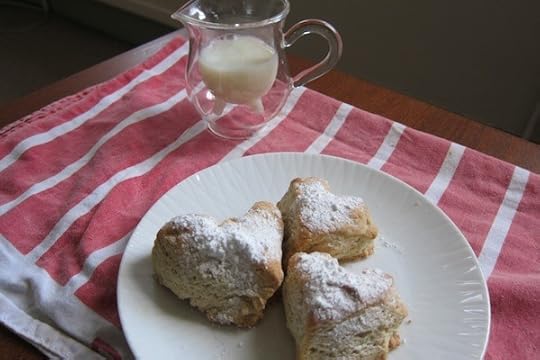
Heart-shaped cakes and the coolest milk jug in all the prairie
Verdict:
“Heart-shaped cakes” is a euphemism for lumpy chunks of dry dough. Because the Ingalls did not bake this treat with eggs or baking powder, the cakes were less like cakes and more like biscuits coated in powdered sugar (Gwyneth Paltrow’s worst nightmare).
After careful examination we have decided that these cakes are the pioneer’s version of the Poptart – a heavy pastry that causes children’s hearts to rejoice.
To make the most out of your lard and buttermilk biscuits, we recommend that you add strawberries and whipped cream. The cakes will soak up the juices, creating a version of strawberry shortcake.
Whatever you do, please don’t stuff them into someone else’s socks as a gift. Unless you then want to go beat that person with said sock. In that case, it would probably work pretty well.
Happy Birthday, Laura Ingalls Wilder! We have six more weeks of winter ahead of us, but we have your starchy cakes and spicy pies and lard biscuits (as well as tales from life on the prairie) to keep us warm.
Graduates in Wonderland
We're Americans, but we write from London! Our daily blog has travel tips, career advice, British traditions investigated and much more nonsense -- welcome!
...more
- Jessica Pan's profile
- 545 followers





